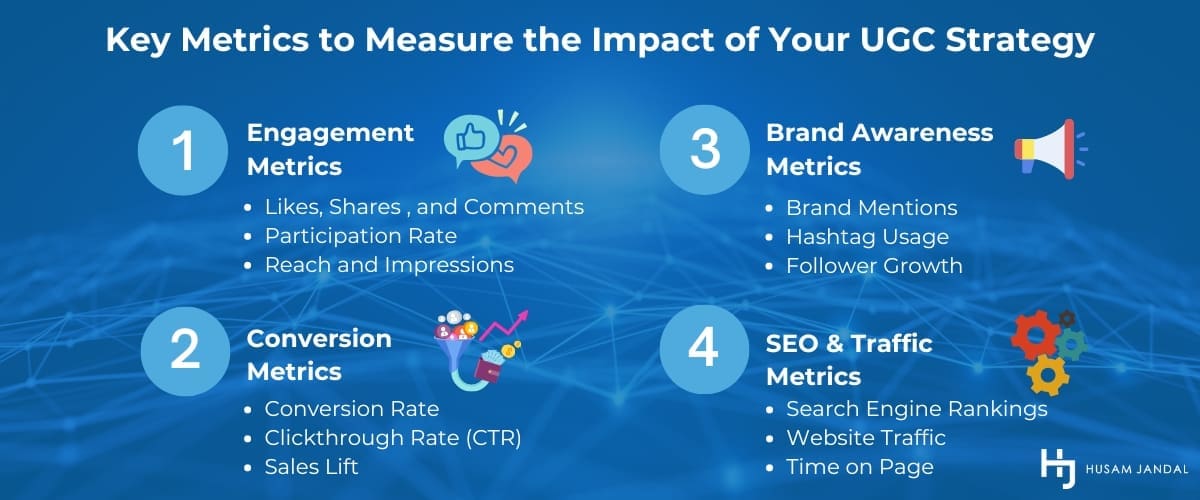 If you’re struggling to engage your audience and boost conversions, you might be overlooking your most valuable asset—your customers’ voices. User-generated content (UGC) is a powerful tool that amplifies trust, builds credibility, and transforms satisfied customers into your brand’s best advocates. By leveraging the authentic experiences of real users, you can create a strategy that resonates with your audience and drives meaningful results. Give me a few minutes, and I’ll walk you through how it works. You’ll also learn how to develop a custom UGC strategy that’s perfectly suited to your brand and audience.
If you’re struggling to engage your audience and boost conversions, you might be overlooking your most valuable asset—your customers’ voices. User-generated content (UGC) is a powerful tool that amplifies trust, builds credibility, and transforms satisfied customers into your brand’s best advocates. By leveraging the authentic experiences of real users, you can create a strategy that resonates with your audience and drives meaningful results. Give me a few minutes, and I’ll walk you through how it works. You’ll also learn how to develop a custom UGC strategy that’s perfectly suited to your brand and audience.
Understanding User-Generated Content
UGC refers to any content—text, images, videos, reviews, etc.—created by people, not brands, and shared publicly. This can include posts on social media, reviews on e-commerce platforms, or even blog comments. What makes UGC so powerful is that it comes directly from customers or users of a product, which can build trust and authenticity in a way that brand-created content often can’t.
Benefits of UGC for Brands
UGC has become a cornerstone for many brands for several reasons.
Increased Trust and Credibility
Consumers are more likely to trust recommendations from other customers than from the brand itself. In fact, 79 percent of people say UGC highly impacts their purchasing decisions, according to a Stackla report.
Cost-Effective Content Creation
Brands can leverage UGC to supplement or even replace expensive content production. Rather than investing heavily in creating photos, videos, or testimonials, businesses can tap into the content their users are already creating, often for free.
Engagement and Community Building
UGC campaigns help brands engage with their audience. When customers see that their content can be featured by the brand, they are often motivated to participate more actively. This not only boosts engagement but fosters a sense of community around the brand.
SEO Benefits
UGC can help with search engine optimization (SEO). Reviews, comments, and social shares can contribute to a website’s SEO by increasing the volume of fresh, relevant content and building backlinks.
The Foundations of a Successful UGC Strategy
To develop a successful UGC strategy, it’s essential to build a strong foundation by defining clear objectives, understanding conversion goals, and knowing your target audience. These are the key elements that ensure UGC is a part of your broader marketing plan, not just a random collection of posts.
Establish Clear Objectives for UGC
The first step in creating a UGC strategy is to identify what you want to achieve. These objectives will shape the content you encourage your users to create, the platforms you prioritize, and how you measure success. Common objectives for UGC campaigns are covered below.
Build Brand Awareness
Many brands use UGC to increase visibility. For instance, Airbnb has leveraged UGC by encouraging users to share their travel experiences. By featuring user photos and videos across its social platforms and website, Airbnb has created a community-driven brand image.
Boost Engagement
UGC is perfect for increasing interaction. A strong B2B example is Cisco’s Cisco Champions program. IT professionals share their experiences and insights using Cisco technology through blogs, social media, and podcasts. Cisco amplifies this content, boosting engagement by highlighting real-world applications and building credibility with its audience.
Drive Conversions
UGC can be used to move potential customers through the sales funnel. For instance, 90 percent of customers say UGC influences their purchase decisions more than traditional marketing, a TurnTo report shows. You can use UGC directly on product pages to improve conversion rates. This can increase conversion rates by 200 percent, according to Yotpo.
Identify Your Target Audience and Their Preferences
Understanding who your audience is and what motivates them is critical to any marketing effort, and UGC is no exception. Not every type of content will resonate with every audience, so it’s important to tailor your UGC strategy to fit their preferences.
Know Your Audience

Consider the demographics of your target audience. Are they younger and more active on platforms like TikTok or Instagram? Or are they professionals who spend time on LinkedIn? Knowing where your audience engages online will help you choose the right platforms and formats for your UGC strategy.
Identify the Right Content
It’s not just about where your audience is but also the type of content they prefer. Do they respond well to video, or are reviews and testimonials more likely to resonate? For example, Lululemon targets active individuals and encourages them to share fitness journeys using their gear on Instagram. Since their audience is visually oriented and active, photos and short-form videos work best.
Creating a Framework for Collecting User-Generated Content
Creating a framework for collecting UGC is essential for driving participation, ensuring quality content, and maximizing its impact. A well-structured plan will encourage audience involvement and help manage and curate the incoming content efficiently. Let’s take a look at how to approach it.
Encourage Audience Participation
The first step in collecting UGC is to make participation simple and appealing. Audiences are more likely to engage if they feel that their content will be valued, recognized, or rewarded. Here are some effective ways to encourage participation.
Clear Call to Action
Be explicit about what you want your audience to do. Whether it’s submitting a testimonial, sharing a photo, or writing a review, make the instructions clear. For example, Salesforce encourages its customers to share success stories using Salesforce tools via the #SalesforceOhana hashtag on LinkedIn and Twitter. Salesforce provides clear guidance on how users can participate by sharing stories, case studies, and innovations with their solutions, often highlighting these contributions at events or featuring them in their content. This not only boosts engagement but also showcases real-world business applications of their software.
Create Incentives
Rewarding participation can be a big motivator. This could range from giving recognition by featuring user content on your website or social media to offering tangible rewards like discounts, giveaways, or special mentions. The idea is to provide something in return for their effort, which makes the process more engaging.
Simplify the Process
The easier it is for users to contribute, the higher the likelihood they will. Offer various channels (social media, direct uploads to your website, or hashtag campaigns) and minimize steps required to participate. For instance, providing an easy upload link on your website or creating a hashtag for users to tag on social media reduces friction.
Contests, Hashtags, and Social Media Drives
Campaigns that leverage contests, hashtags, and social media are powerful ways to generate UGC at scale. These tools not only motivate users to create content but also amplify your brand’s reach.
Contests
Running a contest is an excellent way to spur UGC. For example, Adobe frequently holds design challenges where users submit their work using Adobe tools. The reward could be anything from product giveaways to professional exposure. The combination of competition and reward boosts participation while yielding high-quality content.
Hashtags
Creating a unique hashtag for your campaign makes it easy for users to participate and helps you track submissions. One successful B2B example is Cisco’s #WeAreCisco campaign, where employees share their experiences working at Cisco. The hashtag helps curate authentic employee stories, which enhance Cisco’s employer branding.
Social Media Drives
Social platforms like Instagram, LinkedIn, and TikTok make it easy to launch UGC campaigns. Encourage users to post with a specific theme or product and share their content using a hashtag or by tagging your business. This not only generates content but also widens your brand’s exposure across different audiences.
Manage and Curate UGC Effectively
While collecting UGC is essential, managing and curating the content ensures that it aligns with your brand’s message and quality standards. Here are some key steps to take.
Set Guidelines
Providing clear guidelines on what kind of content you’re looking for ensures the UGC is relevant and on-brand. For example, a software company may ask users to submit case studies about how they solved specific business challenges with their software. This helps ensure the content is aligned with business objectives.
Curate Content
Not all UGC will be fit for immediate use, so having a content curation process in place is crucial. Appoint a team or use tools to review submissions to filter for quality, appropriateness, and alignment with your brand. Many companies use platforms like TINT or Yotpo to manage and organize UGC efficiently, enabling them to sort, select, and publish high-quality submissions easily.
Be Mindful of Legal Considerations
Ensure that you have the proper rights to use the content. This often means including a clause in your terms of service or directly asking for permission to feature user content. You can make this part of the submission process, such as asking users to agree to terms when they upload or submit their UGC.
Recognize Contributors
One of the best ways to continue generating high-quality UGC is to recognize and reward the people who participate. Featuring users in your campaigns, on your website, or across your social platforms builds a stronger connection between the brand and the user. It also encourages others to join in.
Measuring the Impact of Your UGC Strategy
To truly understand the effectiveness of your UGC strategy, you need to measure its impact. Simply collecting content isn’t enough; you need to track the right metrics to see how UGC influences your brand’s growth, engagement, and conversions. Whether your goal is increasing brand awareness, boosting engagement, or driving sales, setting clear key performance indicators (KPIs) will help you quantify success and optimize your strategy over time.
Key Metrics to Track UGC Success

Next, let’s cover some of the most important metrics to monitor for a UGC strategy tailored to specific goals.
Engagement Metrics
Engagement is one of the most direct ways to measure the effectiveness of UGC. If your audience is actively interacting with the content, that’s a good sign it’s resonating with them.
Likes, Shares, and Comments
Monitor how often your UGC posts are liked, shared, and commented on across platforms like LinkedIn or Twitter. High engagement signals that your content is sparking interest and encouraging participation. A B2B example is IBM, which tracks how well its customer success stories and tech solutions posts are shared across LinkedIn.
Participation Rate
Measure how many users are contributing content. If you’ve launched a hashtag campaign or contest, track the number of submissions or uses of your campaign hashtag. If the participation rate is low, you may need to adjust your call to action or incentivize the process better.
Social Media Reach and Impressions
These metrics show how many people have seen UGC related to your brand. When users share your content or post their own, it often expands your reach to their followers, growing your brand’s visibility.
Conversion Metrics
UGC can have a direct impact on your bottom line by influencing purchasing decisions. Measuring conversions tied to UGC helps assess whether it’s driving customers further down the sales funnel.
Conversion Rate
Track how often UGC leads to a desired action, such as filling out a form, signing up for a webinar, or making a purchase. For example, if you feature customer testimonials or case studies on landing pages, monitor whether these pages convert at higher rates compared to non-UGC pages.
Clickthrough Rate (CTR)
Analyze the performance of UGC in ads or email campaigns. If UGC is part of your paid social ads or email newsletters, track how often people click through to your website after viewing UGC.
Sales Lift
Measure if there’s an increase in sales that can be directly attributed to UGC. For example, if UGC content like product reviews or case studies is featured on product pages, track whether these pages see higher sales rates compared to those without UGC.
Brand Awareness Metrics
If your goal is to boost brand awareness, metrics that gauge reach and visibility will give you a clear idea of how well your UGC strategy is working.
Brand Mentions
Track how often your brand is mentioned across social media, blogs, and forums. UGC campaigns often lead to increased mentions as more users discuss and share your brand. Tools like Mention or Hootsuite can help track this. A free alternative is Google Alerts, which will notify you when your selected terms appear in search results.
Hashtag Usage
For campaigns centered around a specific hashtag, it’s crucial to measure how often the hashtag is being used.
Follower Growth
UGC campaigns can lead to an increase in followers on social media platforms. If your campaign is generating a lot of buzz, it can attract new audiences, which is reflected in follower growth on platforms like LinkedIn or Twitter.
SEO and Traffic Metrics
UGC can help improve your search engine rankings and website traffic, making SEO and traffic metrics important to monitor.
Search Engine Rankings
UGC, such as customer reviews or testimonials, can improve your website’s SEO by providing fresh, relevant content. Track your rankings for keywords related to your brand and monitor whether UGC content pages perform better.
Website Traffic
Monitor traffic to pages featuring UGC. For example, if user reviews are displayed on your product or service pages, compare the traffic to those pages before and after adding the UGC. A boost in traffic can be a sign that UGC is drawing more visitors to your site.
Time on Page
UGC often increases engagement, leading visitors to spend more time on your website. If visitors spend more time on pages featuring UGC, such as case studies or testimonial videos, it shows they find the content valuable and engaging.

Get Help Maximizing the Benefits of UGC for Your Brand
People come into contact with UGC all the time but rarely recognize it as part of a marketing strategy because it looks organic. However, a lot of work goes into making it look effortless and weaving it into marketing materials to maximize its value. If you’d like to explore creating a comprehensive digital marketing plan that includes UGC and other advanced tactics, let’s talk. Contact me for a complimentary consultation.
User-Generated Content Strategy FAQs
How can businesses encourage customers to create UGC?
Businesses can encourage UGC by offering clear instructions, running contests, and using incentives like discounts or giveaways. Engaging with customers on social media and featuring their content also motivates participation. Simplifying the process, such as using hashtags or providing easy upload options, removes barriers and encourages contributions.
What are the key metrics to measure the success of a UGC campaign?
Key metrics include engagement rates (likes, shares, comments), participation rate (how many users contribute), and conversion metrics like sales lift and click-through rates. Additionally, tracking brand awareness metrics (mentions, reach) and SEO/traffic metrics (search rankings, time on page) helps gauge the impact of UGC on visibility and conversions.
How can UGC improve brand awareness and visibility?
UGC improves brand awareness by amplifying content through social shares and mentions, reaching wider audiences. When customers post about their experiences, it introduces the brand to their followers. Hashtags and UGC campaigns encourage content sharing, creating organic buzz and expanding reach. UGC also helps improve SEO, driving more traffic to your site.
What are some examples of successful B2B UGC campaigns?
One example is Cisco’s Cisco Champions program, where IT professionals share their experiences with Cisco products. Another is Salesforce’s #SalesforceOhana, where users post success stories about Salesforce tools. Both examples show how brands use UGC to foster community, highlight real-world applications, and increase engagement with their audience.
How do hashtags help with collecting user-generated content?
Hashtags allow brands to easily track and gather UGC by creating a unified tag for content. They encourage users to share posts using the brand’s hashtag, which makes it simpler for companies to discover, curate, and showcase customer-generated content. Hashtags also expand visibility by enabling users to join the conversation and amplify brand reach.
What are the best practices for managing and curating UGC?
Best practices include setting clear guidelines for content, using tools to filter submissions for quality and relevance, and obtaining permission to use UGC. Curating high-quality content that aligns with your brand message is key. Regularly engaging with users who contribute and recognizing their efforts helps foster continued participation.
How can UGC help drive conversions and sales?
UGC builds trust and authenticity, making potential customers more likely to convert. Featuring customer testimonials, reviews, or case studies on landing pages boosts credibility and influences purchase decisions. Product pages with UGC can increase conversion rates by up to 200 percent, directly impacting sales.
What tools can businesses use to track the impact of UGC?
Businesses can use platforms like Hootsuite or Sprout Social to track UGC engagement metrics, while Yotpo and TINT help manage, curate, and display UGC. For tracking sales and conversions, Google Analytics is useful. These tools provide insights into how UGC affects brand visibility, engagement, and conversion rates.
What types of UGC should businesses focus on for brand engagement?
The most impactful types of UGC include customer testimonials, product reviews, case studies, and social media posts featuring the brand’s products. B2B brands often benefit from sharing success stories, while B2C brands can focus on visual content, like photos and videos, to engage customers and create a sense of community.





































































